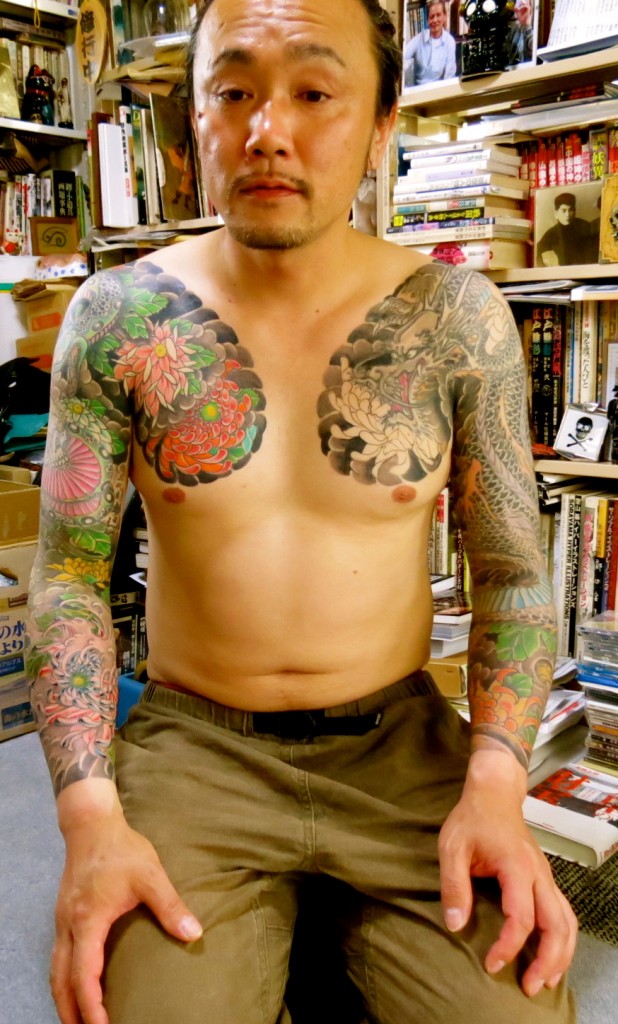Tattoos are as Japanese as sushi, samurai, and yakuza but in recent years with the crackdown on organized crime (the yakuza), tattoos have become increasingly socially unacceptable while many younger Japanese and people living abroad have embraced tattoos as a fashion item.
In December last year, the government of Saitama Prefecture submitted a bill to revise local ordinances to prohibit tattoos under the age of 18. A fine of up to 500,000 yen will be levied on the violators of the law. If a space is provided to tattoo on young people under 18, there is a fine of up to 300,000 yen for the tattoo parlor owners. If the law is passed it will go into effect as of February 1st, this year.
Japan has waged many fruitless wars in the past and the latest war is a war on tattoos. Kicking it off was the Mayor of Osaka, the son of a yakuza boss, who as most yakuza are, was probably heavily tattooed.
In May 2012, the mayor of Osaka and founder of the Nippon Ishin no Kai (Japan Restoration Party), created a huge controversy by ordering all public employees to confess to whether they had tattoos or not. In Japan, where tattoos are seen as a sign of being a yakuza, (member of the Japanese mafia), the tattoo “witch hunt” is in danger of alienating a large number of Japanese citizens and tourists as “tattoos” become more and more fashionable. Ironically, due to a series of laws cracking down on organized crime, the yakuza themselves are ordering their members to remove tattoos or not get them in the first place. One yakuza boss and tattoo artist laments, “All of my customers now are straight people (katagi). No yakuza in his right mind gets a tattoo now. You can’t do business that way. You can’t rise up the underworld ladder.”’
According to AERA magazine’s June issue (2012), at least two people in the Osaka metropolitan area have removed their tattoos after the mayor of Osaka announced the city’s crackdown on tattoos.
The young and charismatic mayor of Osaka, Toru Hashimoto, who was elected in 2011, has been compared to Adolf Hitler in the Japanese media for his authoritarian governing style, showing that Godwin’s rule applies even in Japan. Although, Hashimoto does have some fascist tendencies. It’s hard to really root for a guy who rose to stardom under the tutelage of yakuza associate and lousy comedian Shimada Shinsuke, who had Hashimoto appear on his variety show about laws in Japan. Hashimoto also got his start as lawyer for consumer loan outfits, Japan’s equivalent of legal loan-sharking, which doesn’t exactly make him a champion of the downtrodden. Never mind.
From May to June this year, he ordered an official survey upon the Osaka civil servants to reveal whether they wear a tattoo on a visible part of their bodies.
Mr. Hashimoto, 42, announced a crack down on tattoo bearers who work in the public sector in Osaka last May. After a survey was conducted, the people of Osaka decided, that public servants should not wear tattoos, “because those who see them feel ‘awkward,’” the spokesman of the Osaka city hall explained. The mayor Osaka then requested all the public servants to indicate how big and where their tattoos were located, in an official letter.
The root of this controversial crackdown on tattoos was sparked by the case of a welfare officer who intimidated children by exhibiting his tattoos. “We do not wish the tattoo to be visible to the eyes of the public, we simply would like them to hide their tattoos with clothes or band aids, if they are visible,” the spokesman said.
To conduct the survey, the city hall of Osaka asked the public servants to respond to their inquiry, which is a “work-related instruction.”
After May 2012, the esthetic surgery clinics reported that tattoo related issues and requests from patients “to remove their tattoos” had increased by 25% and are still increasing, according to AERA.
According to a medical doctor interviewed by AERA, there are three ways to clinically erase a tattoo: the laser ablation, the resection and the food technologies.
It should be pointed out that this policy is not going to become a law, but simply “the ethics of work” in Osaka, and the staff will be requested not to exhibit their tattoos at work.
In order to target the concerned staff, the city of Osaka sent a written request to 35,000 people. 113 replied that they had tattoos in a visible place on their bodies.
In December 2012, three Osaka municipal workers who were punished for refusing to respond to the survey have submitted a petition to the mayor of Osaka urging him to revoke the disciplinary action, Kyodo News reported. They submitted the signatures of 3,205 people. The supporters who wish to revoke Hashimoto’s disciplinary measures say that the Osaka Municipal government has “violated human rights.”
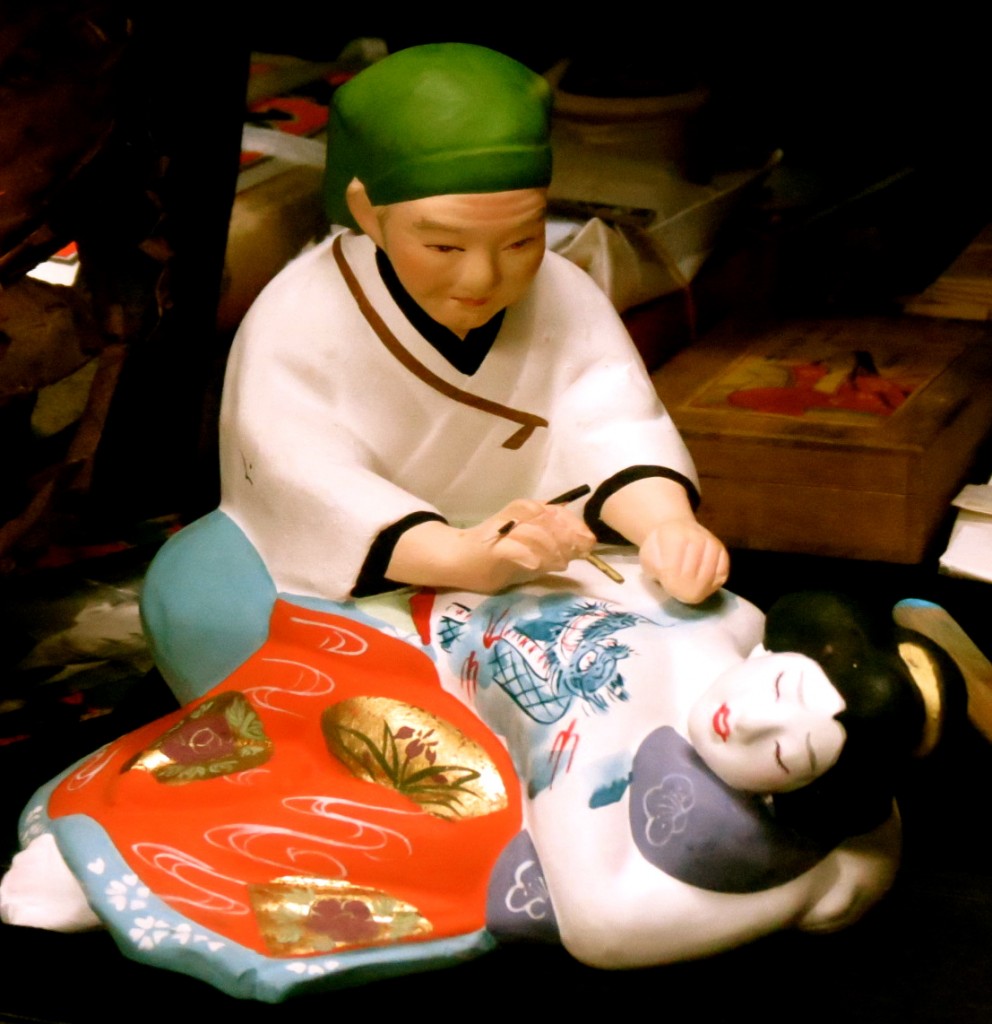
A sculpture found at the Tattoo Museum owned by Horiyoshi the Third in Yokohama, 15 minutes away from his work studio
According to Manami Okazaki, the author of Tattoo in Japan: Traditional and Modern Styles, who researched in depth the current situation of tattoos and those who wear them in modern Japan, “With the popularity of tattoos in America, with several reality TV shows and celebrity tattoo artists, tattoos are increasingly popular among young people in Japan.” Whereas before, more yakuza people used to wear tattoos and “the gang connotations were stronger.” However, the historical connection to the yakuza still remains overall, because the recent crack down on tattoos in Japanese society has increased more than ever, she explained.
An explanation of the decline of yakuza clientele and the increase of ordinary citizen clientele given by Hokuo, a tattoo master in Japan interviewed by Manami Okazaki, is that nowadays, the yakuza do not have the money to buy extravagances such as whole body tattoos. A decade ago a full-body tattoo could take up to 500 hours to complete and cost over 5 million yen.
The cooperative association of Hakone hot springs and ryokan said that the traditional Japaneseirezumi (入れ墨)generate “fear and awkwardness,” generally because they are associated with members of the anti-social forces (反社会的勢力. The Hakone hot spring association spokesman said that, people wearing tattoos are now increasing and “discussions are raising everywhere in Japan, because there is no definition or explanation of the ‘fashionable tattoo’ and the traditional irezumi.” He also added that there was no clear explanation given to whether this is “good or this is bad,” but the Japanese irezumi is forbidden everywhere, in public baths, in swimming pools, etc.
He said that the problem is when the tattoo creates “fear and uneasiness.” “It’s a difficult problem. It’s true that the irezumi could be seen as part of Japanese culture, and people who are not members of the yakuza are also wearing tattoos. However, in general, in Japan, tattoos are not good,” he concluded.
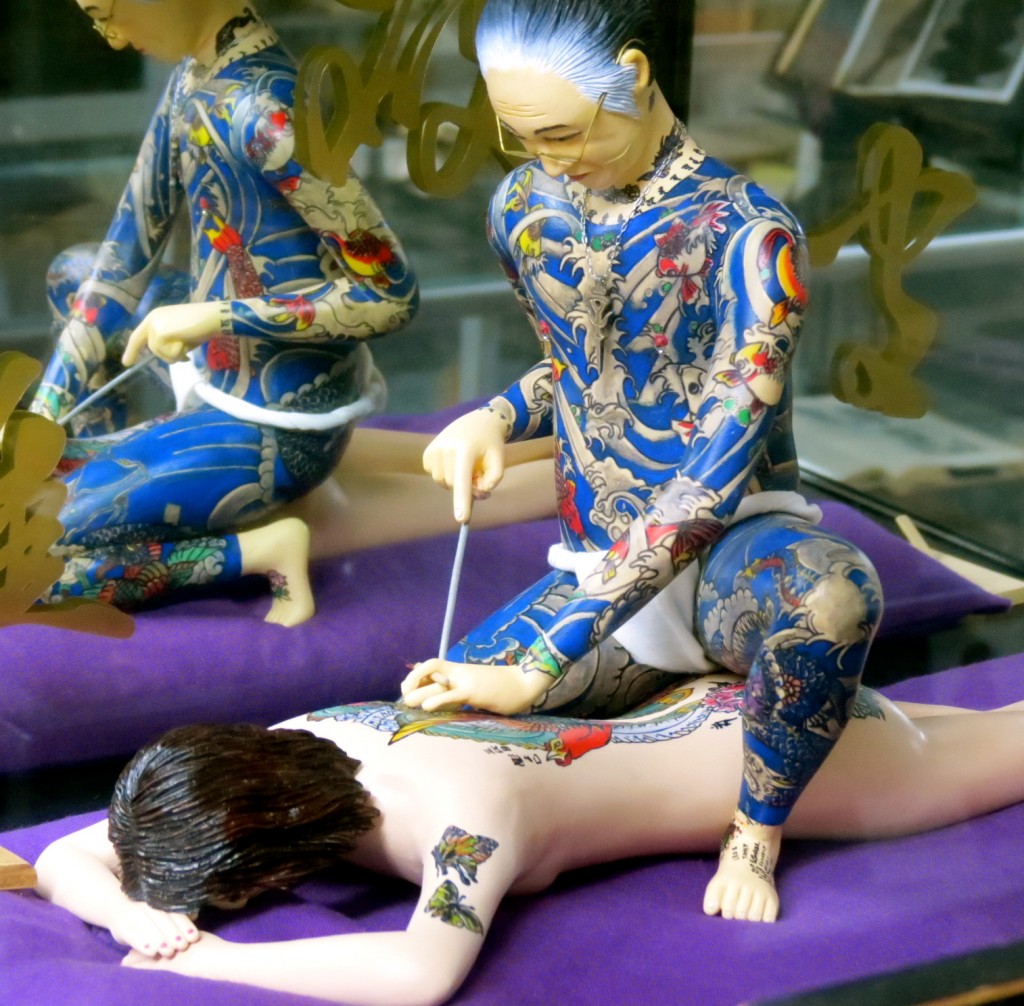
Another figurine found at the Tattoo Museum, featuring Horiyoshi III working on the body of a woman
The Asahi Newspaper in Hokkaido reported that a new initiative rose among the Hokkaido public baths owners’ union who submitted a proposal to restudy the manuals for letting tattooed customers use the facilities.
The initiative, currently under consideration, was raised as some owners started to say that: “excluding tattooed people is discrimination.” According to the Asahi Shinbun, since the Hokkaido organized crime exclusionary laws went into effect in 2011, this reality has raised other sorts of trouble. 245 public bath owners have been inquired on this issue. 75% have replied to the inquiry.
Currently, 75% of the public baths owners allow tattooed people to use their facilities, 19% believe that they might lose customers if they ban them, 17% answered they fear that “not letting tattooed people in might create trouble with the other customers,” and 36% answered that they have nothing to report in particular. 24% of them informed their customers about the ban on tattoos on posters or orally. 71% answered they have not announced anything in particular.
Most of the public baths owners reported that their main concern was to “establish the right limits between the Japanese traditional irezumi and the fashion tattoo.” Many also reported that even though they announce the ban on posters, “it is difficult to actually refuse them entry.” The result of the survey basically announced that 60% of the poll requested that “each public bath owners should have the freedom to exercise the right to ban or allow entry to tattooed individuals based on their own judgement.” And 16% wish the rules to be changed, and are considering changing the content of the manuals. The reason given is that discriminating against tattooed people would be a violation of the human rights.

Archives of Japanese tattoos showed how they were used to brand criminals explaining their meaning on different location of the body
The spokesman of Hokkaido’s union of public bath owners said that they did not intend to change the manuals only because of the tattoos issue. They conducted the survey because they received some complaints over the last few years. The revised manuals have been published in the summer of 2012. “Some people think that the tattoos are a nuisance. But the opinion are quite diverse, it is fifty-fifty,” the union member said.
The Hokkaido Organized Crime Exclusionary Ordinance Team told JSRC that the inquiry started in November last year and that the survey does not judge whether the tattoos are “good” or “bad.” The Hokkaido organized crime exclusionary laws that went into effect in 2011 evoke the issue in a “hygienic sense,” and also from the point of view of the human rights and discrimination against tattooed people.
With regard to the hygienic issue, the spokesman of the Hokkaido law enforcement unit explained the hygienic issues of tattoos, such as transmissible diseases. Tattooed customers’ “hygienic issues” were compared to customers with tuberculosis.
“The reason we have to kindly ask certain customers not to use the public facilities is because we would like to have ‘healthy bathtubs’, the message is ‘let’s have clean public baths. People tend to feel awkward on the hygienic level when they bathe with tattooed people,” he added.
Tom Stringer, 25, a British English teacher in Osaka for four years was refused entry to become a member of a gym spa called Costa, because he was wearing an 8 cm diameter circular tattoo on his chest. First, when he tried to apply, the staff asked him if he had any tattoos at all, he answered honestly, and he was banned from the gym.
He said he had to wait 7 months before reapplying, hoping that the club had forgotten about him. Tom left the Costa gym earlier this year, but during the whole time he was attending the gym facilities, he could not use the shower, nor could he use the hot tub. In the changing room, he was constantly trying not to be seen by the staff members, and had to change facing the wall. It was a supreme pain in the ass. (Metaphorically.)
In Sapporo this year, Tom was also discriminated because of his tattoo on hischest. Inside the changing room of a spa, while he was getting ready to use the facility, he was kindly asked to put back his clothes and leave the onsen, when a female cleaning staff member came in and saw his tattoo.
In his four years living in Japan, Tom was discriminated twice for wearing a tattoo. At the Language school in Osaka where he is currently teaching English, no one has treated him badly because of his tattoo.
Foreigners or tourists are not the only victims of tattoo discrimination. The surgeon interviewed by AERA also reported the case of a young Japanese woman who was discriminated over her tattoos. One of the surgeon’s patients, a young woman in her twenties, told him that a employee of a spa kicked her out while she was washing her hair, and did not let her finish bathing. She told him she remembered crying bitterly after that experience.
Horiyoshi III, Japan’s most famous tattoo artist, and also said to be the inventor of a new and better tools for wabori (和彫り)traditional Japanese tattooing, spoke to JSRC in his tattoo studio in Yokohama. “I think that the Western people also have a prefabricated idea that the Japanese traditionalirezumi are designed for the yakuza. Someone once told me ‘I want a yakuza-style tattoo.’ It is a common recognition of it. But it is not the yakuza’s fault if their tattoos are designated in such way.”
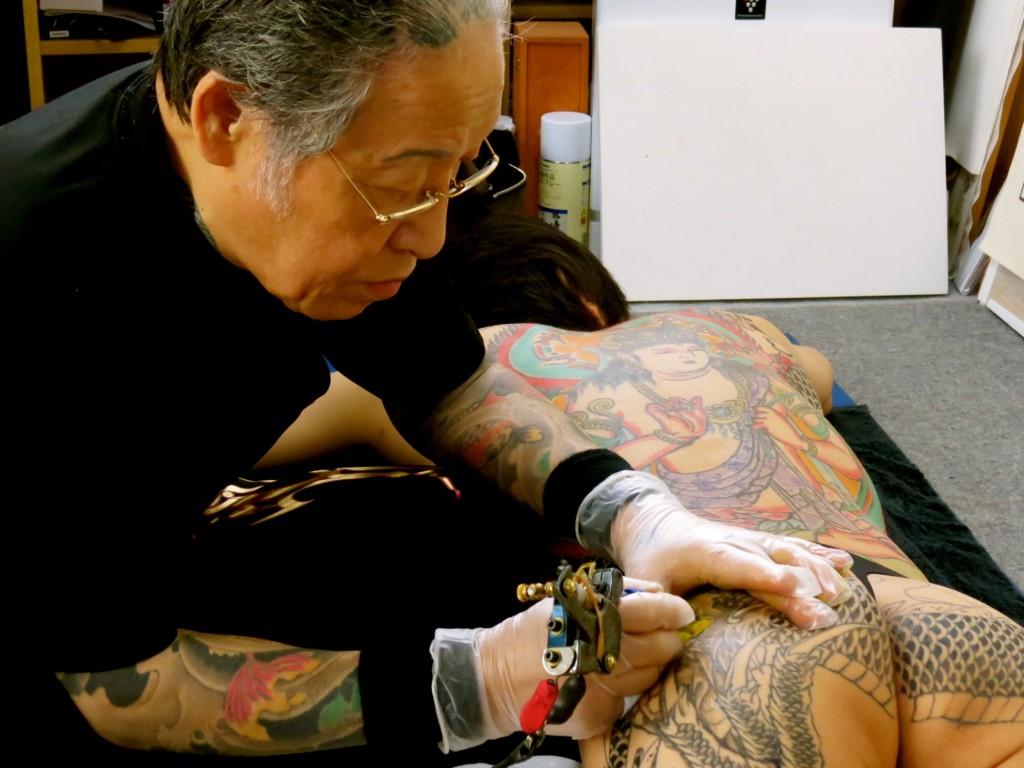
Horiyoshi the Third, the world’s most famous tattoo artist, at work in his studio in Yokohama
Horiyoshi the Third claims that his clients are 90% “ordinary people”, among them salary men, musicians, bar hosts, “Of course I do have yakuza clients as well.” However he said that he has much fewer yakuza clients than he use to have in the past. “Some kumi, or organized crime groups, nowadays order their members to erase their tattoos with lasers, if they can afford it.”
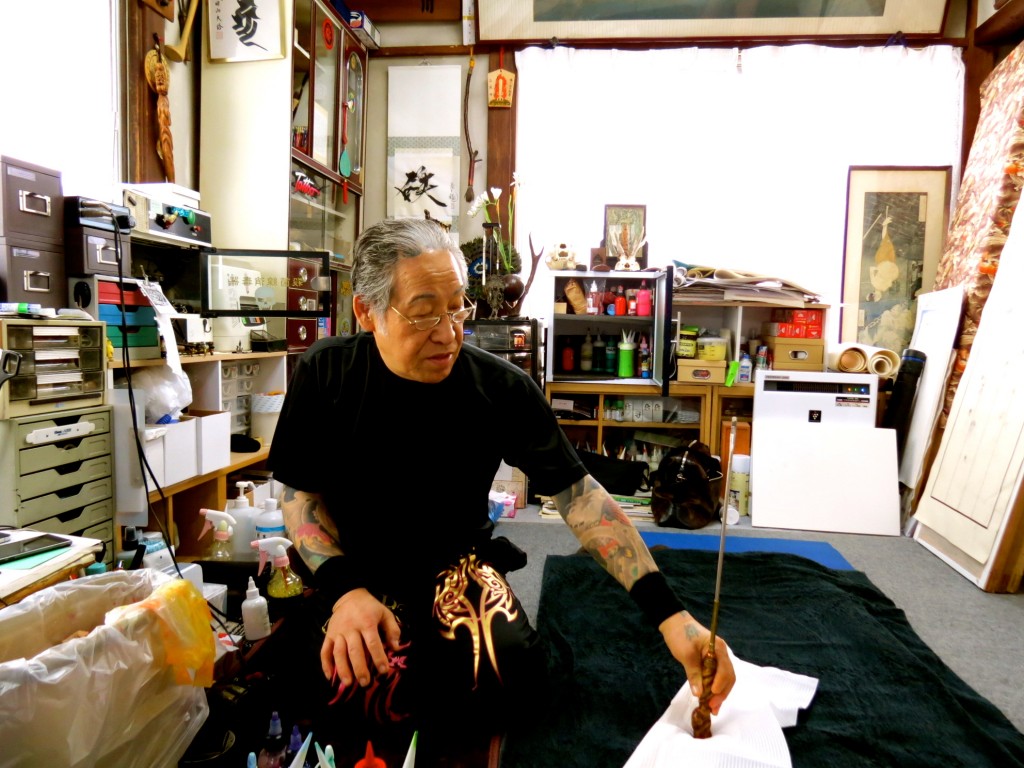
Horiyoshi III is renown for using the Tebori you no nomi
It is difficult to say whether the wabori Japanese traditional tattoo hurts more or less than the electric needle tattoo. Pain is like tickle, it is not a feeling that you can measure. You can measure the weight of a person, for example, but you cannot measure pain. Some people say they are afraid of the electric sound of the needle.
Despite the crackdown on tattoos, Horiyoshi the Third does not believe that his art, together with the art of tattoos in general will ever die after his death. “I am a descendant of this tradition, and despite the government bans our culture has survived. The tattoo will never die. It will evolve. Since the Edo period, the tool, the designs and technologies are constantly evolving. Therefore my art will evolve, rather than disappear.”
“Ten years ago, 10 percent of my clients were foreign and this year, I have 40 percent of my clients are non-Japanese. The number of Japanese tattoo fans is continuously increasing over the years,” he added.
A mid-level yakuza boss and tattoo artist in his spare time explained to JSRC that during the Edo period, there was no real jobs related to the firemen, it was the carpenters or the workers on construction sites who volunteered in stopping fires when such accidents occurred. “They [the firemen] were the ones known for wearing whole body tattoos. It seems like this category of people were those who did the work that nobody else can do or does not want to do, like the ancestors of the current anti-social forces.”
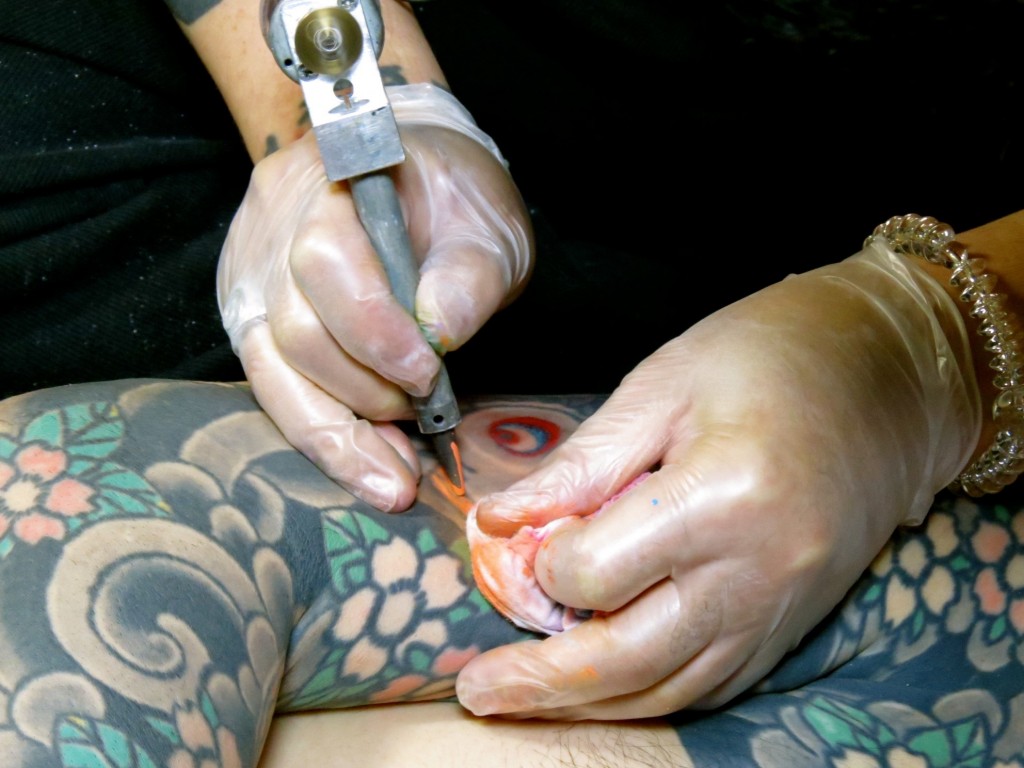
A yakuza boss and part-time tattoo artist at work.
According to this tattoo artist on his spare time, the layer of ink inside the skin helped the firefighters to endure the heat of the fire. Whether this is true or not is hard to say–there hasn’t really been a study of tattoos and fire-fighter endurance.
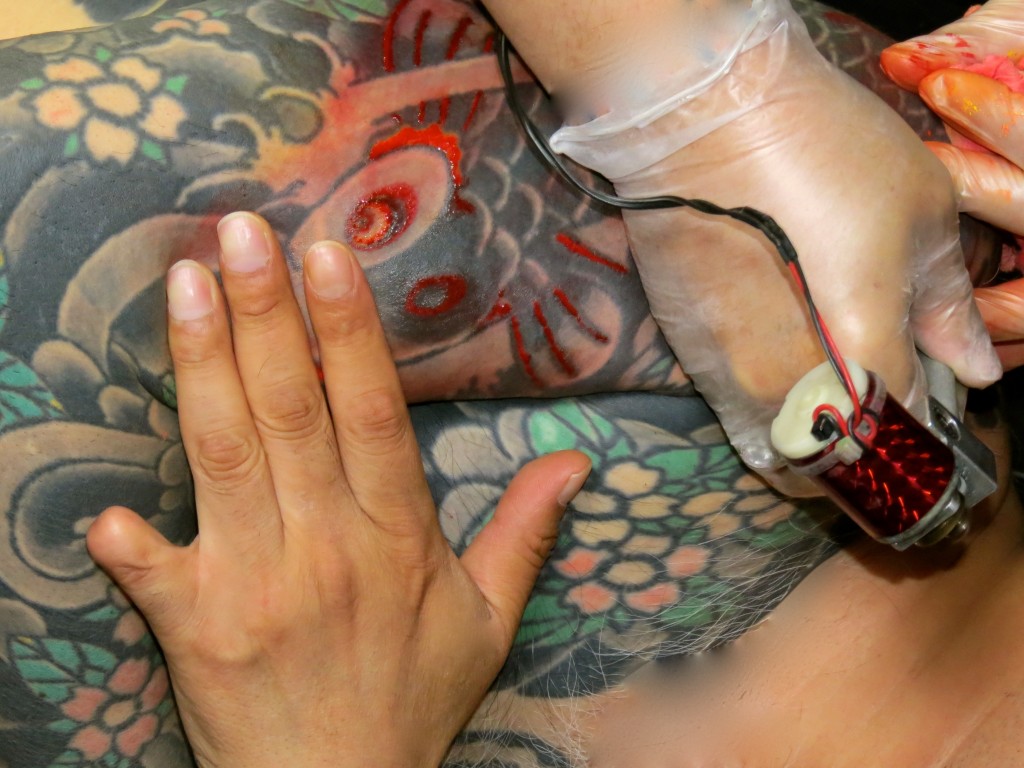
John, 52, is a computer engineer currently based in California, who worked seven years in Japan in the past. He started his whole body tattoo at age 40 with Horiyoshi the Third, in Yokohama. John travels two weeks a year to Japan to get his tattoo finished year after year by his favorite tattoo master. John has been tattooed by Horiyoshi III for 12 years but the tattoo is not yet complete.
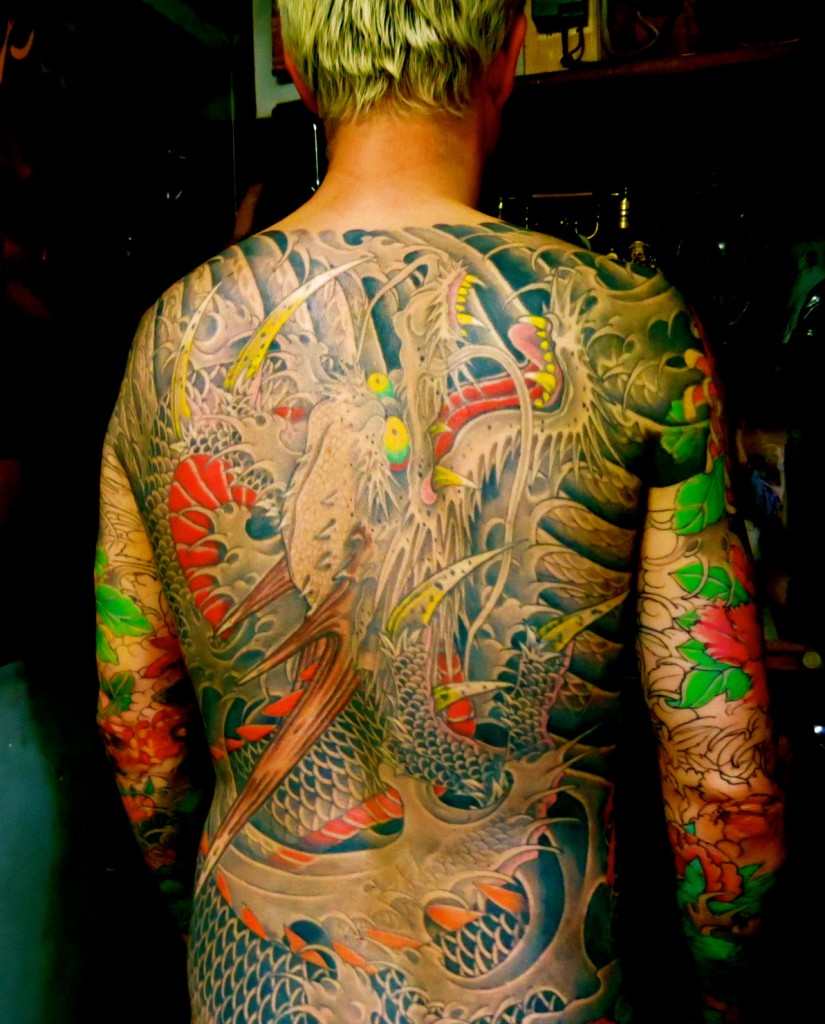
John has been tattooed by Horiyoshi III for several years but the tattoo is not yet complete
John operates in the business world, and as an educated man with a career, he admits there is a certain amount of risk concerning what his colleagues would think about his tattoos. When asked if he faces social discrimination at work in California for his tattoos, he replied: “Tattoos are not business wear. I do not display or mention them in professional situations. I feel that concealed tattoos should not matter. It’s the same as with a suit. When the situation calls for a business suit, I must actually wear one. It does not matter how many are hidden in my closet.”
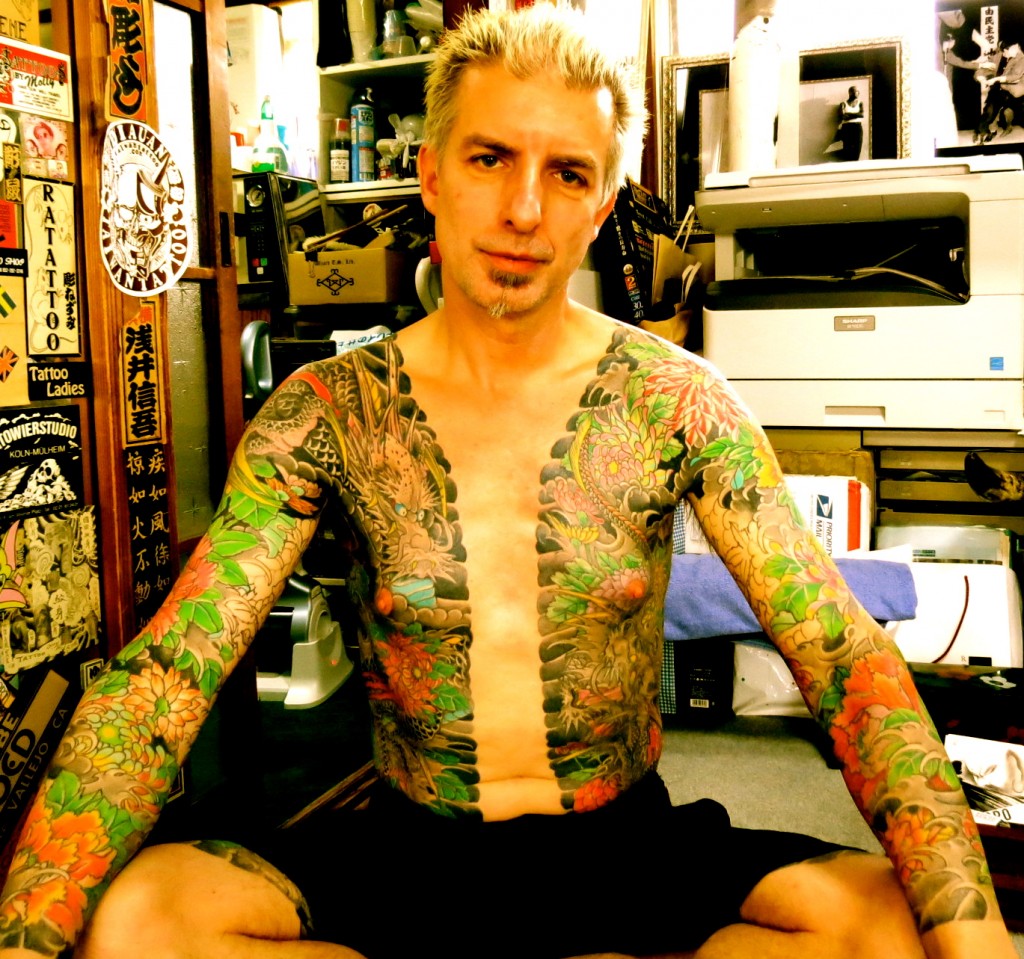
John
A special agent with the Australian Federal Police said on background, “We don’t see the young yakuza coming in with tattoos or missing fingers. The new generation is all cleanskins.*”
One Japanese police officer states, “If we continue to discriminate against people with tattoos or ex-yakuza, we’ll never be able to reintegrate them into society. Tattoos are no longer a reliable indication of whether a person is in the yakuza at present. It’s time the laws reflected the reality.”
Mr. Kazuki Kai, 42, from Kyushu said he heard about Horiyoshi III’s reputation even before he had his tattoo studio in Yokohama. Mr. Kai started to have his first tattoo of a dragon by Horiyoshi-sensei on his left arm 23 years ago. He abandoned having any tattoo for a while and started again a new tattoo of a snake on his right arm and shoulder this January 2012. (You can see the difference in the colors.)
Mr. Kai works as a harbor blacksmith for a power generation company in Kyushu. He intends to get a whole body tattoo at Horiyoshi the Third’s tattoo studio in Yokohama. He estimates that it will take him another 3 to 4 years. The traditional methods of tattooing in Japan are close to dying out and as Japanese culture adapts to tattoos, Japanese society is experiencing some growing pains. Whether those growing pains even come close to the actual pain of a traditional tattoo is best left to the imagination.
“It is difficult to say whether the wabori Japanese traditional tattoo hurts more or less than the electric needle tattoo. Pain is like tickle, it is not a feeling that you can measure. You can measure the weight of a person, for example, but you cannot measure pain. Some people say they are afraid of the electric sound of the needle.”–Horiyoshi the 3rd
